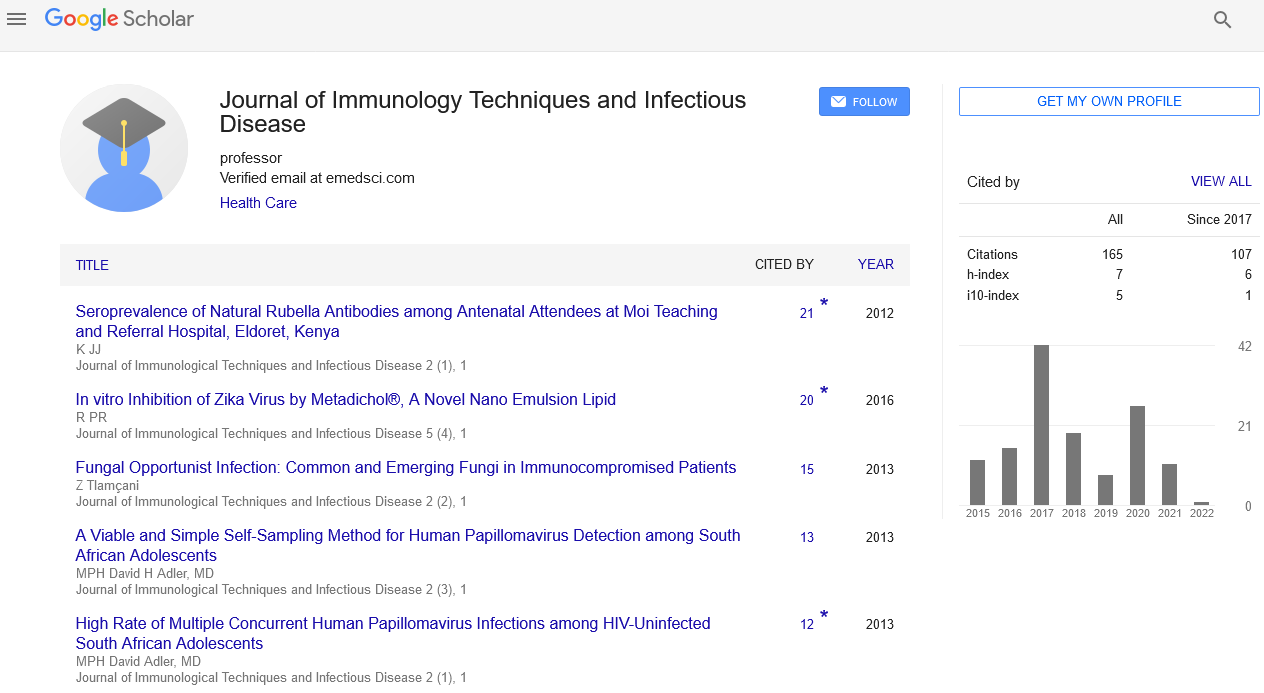Perspective, J Immunol Tech Infect Dis Vol: 11 Issue: 1
Imaging in Cancer Immunology: Phenotyping of Multiple Immune Cell Subsets in Situ in FFPE Tissue Sections
Katherine Grinnell*
Department of Viral Pathogenesis and Immunology, Monash University, Melbourne, Australia
*Corresponding Author:
Katherine Grinnell
Department of Viral Pathogenesis and Immunology, Monash University, Melbourne, Australia
E-mail: katherinegrinnell01@gmail.com
Received date: 03 January, 2022, Manuscript No: JIDIT-22-56127;
Editor assigned date: 06 January, 2022; PreQC No. JIDIT-22-56127(PQ);
Reviewed date: 17 January, 2022, QC No. JIDIT-22-56127;
Revised date: 24 January, 2022, Manuscript No. JIDIT-22-56127(R);
Published date: 03 February, 2022, DOI: 10.4172/2329-9541.1000180.
Abstract
Epidemiology is the have a look at and evaluation of the distribution who while and in which styles and determinants of health and disorder situations in described population. It is a cornerstone of public health and shapes policy choices and evidence-based practice by means of identifying risk elements for sickness and goals for preventive healthcare. Epidemiologists assist with take a look at design collection and statistical analysis of facts amend interpretation and dissemination of results together with peer review and occasional systematic evaluation [1]. Epidemiology has helped expand methodology utilized in scientific studies public fitness research and to a lesser volume primary research in the biological sciences. Major regions of epidemiological study consist of disorder causation, transmission, outbreak investigation, disease surveillance, environmental epidemiology, forensic epidemiology, occupational epidemiology, screening, biomonitoring, and comparisons of treatment outcomes which includes in scientific trials. Epidemiologists depend upon different scientific disciplines like biology to better understand ailment procedures, records to make green use of the statistics and draw appropriate conclusions, social sciences to better understand proximate and distal reasons, and engineering for exposure assessment
Keywords: Immune Cell, Tissue Sections, Cancer Immunology
Introduction
Epidemiology is the have a look at and evaluation of the distribution who while and in which styles and determinants of health and disorder situations in described population. It is a cornerstone of public health and shapes policy choices and evidence-based practice by means of identifying risk elements for sickness and goals for preventive healthcare. Epidemiologists assist with take a look at design collection and statistical analysis of facts amend interpretation and dissemination of results together with peer review and occasional systematic evaluation [1]. Epidemiology has helped expand methodology utilized in scientific studies public fitness research and to a lesser volume primary research in the biological sciences. Major regions of epidemiological study consist of disorder causation, transmission, outbreak investigation, disease surveillance, environmental epidemiology, forensic epidemiology, occupational epidemiology, screening, biomonitoring, and comparisons of treatment outcomes which includes in scientific trials. Epidemiologists depend upon different scientific disciplines like biology to better understand ailment procedures, records to make green use of the statistics and draw appropriate conclusions, social sciences to better understand proximate and distal reasons, and engineering for exposure assessment [2].
The distinction among epidemic and endemic was first drawn by hippocrates, to differentiate among sicknesses which can be visited upon a populace epidemic from those who live inside a population endemic [3]. The time period epidemiology seems to have first been used to explain the have a look at of epidemics in 1802 via the spanish medical doctor villella in epidemiologia espanola. Epidemiologists also examine the interaction of diseases in a population, a situation known as a syndemic. The time period epidemiology is now widely implemented to cover the description and causation of no longer handiest epidemic, infectious ailment, but of disorder in widespread, inclusive of related conditions. Some examples of subjects examined through epidemiology include as high blood pressure, intellectual contamination and weight problems. Therefore, this epidemiology is primarily based upon how the pattern of the disease reasons trade within the function of humans [4].
Population-based Health Management
Epidemiological practice and the results of epidemiological analysis make a significant contribution to emerging population-based health management frameworks. Modern population-based health management is complex requiring a multiple set of skills medical, political, technological, mathematical, etc. Of which epidemiological practice and analysis is a core component that is unified with management science to provide efficient and effective health care and health guidance to a population [5]. This task requires the forward-looking ability of modern risk management approaches that transform health risk factors incidence prevalence and mortality statistics derived from epidemiological analysis into management metrics that not only guide how a health system responds to current population health issues but also how a health system can be managed to better respond to future potential population health issues [6]. Each of these organizations uses a population-based health management framework called life at risk that combines epidemiological quantitative analysis with demographics, health agency operational research and economics to perform [7]. Measurement of the future potential impact of disease upon the population with respect to new disease cases, prevalence, premature death as well as potential years of life lost from disability and death labour.
Causal Inference
Although epidemiology is sometimes viewed as a collection of statistical tools used to elucidate the associations of exposures to health outcomes, a deeper understanding of this science is that of discovering causal relationships [8]. Correlation does not imply causation is a common theme for much of the epidemiological literature. For epidemiologists, the key is in the term inference. Correlation, or at least association between two variables, is a necessary but not sufficient criterion for the inference that one variable causes the other. Epidemiologists use gathered data and a broad range of biomedical and psychosocial theories in an iterative way to generate or expand theory, to test hypotheses, and to make educated, informed assertions about which relationships are causal, and about exactly how they are causal [9]. Epidemiologists emphasize that the one cause one effect understanding is a simplistic mis-belief. Most outcomes, whether disease or death, are caused by a chain or web consisting of many component causes. Causes can be distinguished as necessary, sufficient or probabilistic conditions. If a necessary condition can be identified and controlled e.g., antibodies to a disease agent, energy in an injury, the harmful outcome can be avoided one tool regularly used to conceptualize the multicausality associated with disease is the causal pie model [10].
References
- Nutter JR (1999) Understanding the interrelationships between botanical human and veterinary epidemiology. Ecosyst Health 5: 131-140. [Crossref], [Google Scholar]
- Garoarsdottir O, Guttormsson L (2009) Public health measures against neonatal tetanus on the island of Vestmannaeyjar (Iceland) during the 19th century. J His Fam 14: 266-279. [Crossref], [Google Scholar]
- Pybus OG, Fraser C, Rambaut A (2013) Evolutionary epidemiology: Preparing for an age of genomic plenty. Philos Trans R Soc Lond B Biol Sci 368: 193. [Crossref], [Google Scholar], [Indexed]
- Ogino S, Fuchs CS, Giovannucci E (2012) How many molecular subtypes? Implications of the unique tumor principle in personalized medicine. Expert Rev Mol Diagn 12: 621-628. [Crossref], [Google Scholar], [Indexed]
- Ogino S, Lochhead P, Chan AT, Nishihara R, Cho E, et al. (2013) Molecular pathological epidemiology of epigenetics: Emerging integrative science to analyze environment host and disease. Mod Pathol 26: 465-484. [Crossref], [Google scholar], [Indexed]
- Curtin K, Slattery ML, Samowitz WS (2011) CpG island methylation in colorectal cancer: Past, present and future. Patholog Res Int 12:2674. [Crossref], [Google Scholar], [Indexed]
- Ku CS, Cooper DN, Wu M, Roukos DH, Pawitan Y, Soong R, et al. ( 2012) Gene discovery in familial cancer syndromes by exome sequencing: Prospects for the elucidation of familial colorectal cancer type X. Mod Pathol 25: 1055-1068. [Crossref], [Google Scholar], [Indexed]
- Chia WK, Ali R, Toh HC (2012) Aspirin as adjuvant therapy for colorectal cancer-reinterpreting paradigms. Nat Rev Clin Oncol 9: 561-570. [Crossref], [Google Scholar], [Indexed]
- Spitz MR, Caporaso NE, Sellers TA (2012) Integrative cancer epidemiology â?? the next generation. Cancer Discov 2: 1087-1090. [Crossref], [Google Scholar], [Indexed]
- Zaidi N, Lupien L, Kuemmerle NB, Kinlaw WB, Swinnen JV, et al. (2013) Lipogenesis and lipolysis: The pathways exploited by the cancer cells to acquire fatty acids. Prog Lipid Res 52: 585-589. [Crossref], [Google Scholar], [Indexed]
 Spanish
Spanish  Chinese
Chinese  Russian
Russian  German
German  French
French  Japanese
Japanese  Portuguese
Portuguese  Hindi
Hindi 
